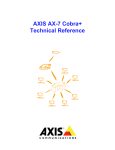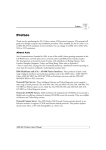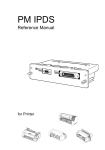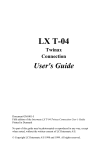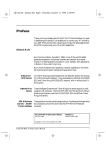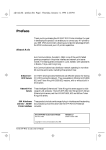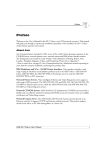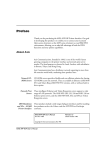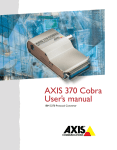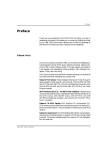Download Axis HP-MIO 2 User`s manual
Transcript
Preface HP MIO Preface Thank you for purchasing the AXIS HP MIO printer interface. Our goal in developing this product is to provide you with a high-quality, high-performance interface between the IBM system environment and your Hewlett-Packard printer, combining the best of both worlds. About Axis Axis Communications is dedicated to provide inventive solutions for network connection of computer peripherals. Since the start in 1984, it has been one of the fastest growing companies in the market. The headquarters are located in Lund, Sweden, with subsidiaries in Boston, Tokyo, and Hong Kong. Axis Communications has a distributor network operating in more than 50 countries world-wide, marketing three product lines: IBM Mainframe and S/3x – AS/400 Printer Interfaces: These products include a wide range of plug-in interfaces and stand-alone products such as the AXIS Cobra+, AXIS 330/370 Cobra, AXIS HP MIO, the AXIS AFP IPDS-to-PostScript converter, and the AXIS AFP MIO/IOP IPDS-to-PCL converters Network Print Servers: These intelligent Ethernet and Token Ring print servers support a wide range of LAN protocols. The AXIS 540, AXIS 560 and AXIS 570 are Ethernet print servers, and the AXIS 640, AXIS 660 and AXIS 670 are Token Ring print servers. The AXIS 150 is an Ethernet print server dedicated to PC networks. CD-ROM Servers: Axis CD-ROM servers allow CD-ROM data to be shared over the network. The product range includes the AXIS 850 and AXIS 851 Ethernet CD-ROM servers as well as the AXIS 950 and AXIS 951 Token Ring CD-ROM servers. AXIS HP MIO User’s Manual 1 HP MIO Preface ABOUT THIS MANUAL This manual will guide you through a simple step-by-step installation and configuration procedure. It is divided into four sections: 1. INTRODUCTION – The AXIS HP MIO board, how it works, where to use it, and its main features. 2. GETTING STARTED – How to install the AXIS HP MIO board into your printer, and how to connect it to the IBM system. 3. CONFIGURATION – How to configure the AXIS HP MIO using the printer’s front panel. 4. ADVANCED FUNCTIONS – An overview of AXIS HP MIO functions beyond the standard IBM printer emulation. The manual applies to the AXIS HP MIO with firmware release 1.21 and subsequent releases until otherwise notified. Please refer to the AXIS HP MIO Technical Reference for further information of functions and parameters. Every care has been taken in the preparation of this manual; if you detect any inaccuracies or omissions, please inform us at the address on the back cover. Axis Communications AB cannot be held responsible for any technical or typographical errors and reserves the right to make changes to the product and manuals without prior notice. 2 AXIS HP MIO User’s Manual Preface HP MIO Emission Notices USA Europe This equipment generates, uses, and can radiate radio frequency energy and if not installed and used in accordance with the instruction manual, may cause interference to radio communications. It has been tested and found to comply with the limits for a Class A computing device pursuant to Subpart B of Part 15 of FCC rules, which are designed to provide reasonable protection against such interference when operated in a commercial environment. Operation of this equipment in a residential area is likely to cause interference in which case the user, at his own expense, will be required to take whatever measures may be required to correct the interference. Shielded cables should be used with this unit to ensure compliance with the Class A limits. This digital equipment fulfils the requirements for radiated emission according to limit B of EN55022/1987, and the requirements for immunity according to EN50082-1/1992 residential, commercial, and light industry. (Compliance is not valid for unshielded network and printer cables.) Trademark Acknowledgements IBM and Hewlett Packard are registered trademarks of the respective holders. AXIS HP MIO User’s Manual Part No: 13142 Revision: 1.2 Dated: June, 1996 Copyright © Axis Communications AB, 1996 AXIS HP MIO User’s Manual 3 HP MIO Preface This page is intentionally blank 4 AXIS HP MIO User’s Manual Table of Contents Table of Contents Section 1 Introduction . . . . . . . . . . . . . . . . . . . . . . . . . . . . . . . . . . . . . . . . . . . . . . . . . . . . . . . 7 How It Works . . . . . . . . . . . . . . . . . . . . . . . . . . . . . . . . . . . . . . . . . . . . . . . . . 8 Where To Use It . . . . . . . . . . . . . . . . . . . . . . . . . . . . . . . . . . . . . . . . . . . . . . 9 Main Features . . . . . . . . . . . . . . . . . . . . . . . . . . . . . . . . . . . . . . . . . . . . . . . . 10 Section 2 Getting Started . . . . . . . . . . . . . . . . . . . . . . . . . . . . . . . . . . . . . . . . . . . . . . . . . . . Hardware Installation . . . . . . . . . . . . . . . . . . . . . . . . . . . . . . . . . . . . . . . . . . Verifying the Installation . . . . . . . . . . . . . . . . . . . . . . . . . . . . . . . . . . . . . . . . Connecting to the System . . . . . . . . . . . . . . . . . . . . . . . . . . . . . . . . . . . . . . 11 12 14 16 Section 3 Configuration . . . . . . . . . . . . . . . . . . . . . . . . . . . . . . . . . . . . . . . . . . . . . . . . . . . . . The Front Panel Menus . . . . . . . . . . . . . . . . . . . . . . . . . . . . . . . . . . . . . . . . System Language (SYSL) . . . . . . . . . . . . . . . . . . . . . . . . . . . . . . . . . . . . . . . IBM Printer Emulation (PREMUL) . . . . . . . . . . . . . . . . . . . . . . . . . . . . . . . . Maximum Page Length (MPL) . . . . . . . . . . . . . . . . . . . . . . . . . . . . . . . . . . . Automatic Orientation (AUTORI) . . . . . . . . . . . . . . . . . . . . . . . . . . . . . . . Page Orientation (PAGEORI) . . . . . . . . . . . . . . . . . . . . . . . . . . . . . . . . . . . Page Size (PAGESIZE) . . . . . . . . . . . . . . . . . . . . . . . . . . . . . . . . . . . . . . . . . Custom Page Width (PAGEWIDTH) . . . . . . . . . . . . . . . . . . . . . . . . . . . . Custom Page Length (PAGELENGTH) . . . . . . . . . . . . . . . . . . . . . . . . . . . Print Parameter List . . . . . . . . . . . . . . . . . . . . . . . . . . . . . . . . . . . . . . . . . . . 17 18 19 20 21 22 23 24 25 26 27 Section 4 Advanced Functions . . . . . . . . . . . . . . . . . . . . . . . . . . . . . . . . . . . . . . . . . . . . . . . Configuration from the System . . . . . . . . . . . . . . . . . . . . . . . . . . . . . . . . . . Hex Transparency . . . . . . . . . . . . . . . . . . . . . . . . . . . . . . . . . . . . . . . . . . . . . Font Selection . . . . . . . . . . . . . . . . . . . . . . . . . . . . . . . . . . . . . . . . . . . . . . . . 29 30 31 32 Appendix A The AXIS HP MIO Rear Panel . . . . . . . . . . . . . . . . . . . . . . . . . . . . . . . . . . . . . . The System Indicator . . . . . . . . . . . . . . . . . . . . . . . . . . . . . . . . . . . . . . . . . . The PC SHARE Indicator . . . . . . . . . . . . . . . . . . . . . . . . . . . . . . . . . . . . . . . The Rotary Switch . . . . . . . . . . . . . . . . . . . . . . . . . . . . . . . . . . . . . . . . . . . . The Coax/Twinax Switch . . . . . . . . . . . . . . . . . . . . . . . . . . . . . . . . . . . . . . . Test Mode . . . . . . . . . . . . . . . . . . . . . . . . . . . . . . . . . . . . . . . . . . . . . . . . . . . 34 34 35 35 35 35 AXIS HP MIO User’s Manual 5 Table of Contents Appendix B System Configuration Guidelines . . . . . . . . . . . . . . . . . . . . . . . . . . . . . . . . . . . . 37 5250/Twinax Host Configuration . . . . . . . . . . . . . . . . . . . . . . . . . . . . . . . . 37 3270 Host Configuration . . . . . . . . . . . . . . . . . . . . . . . . . . . . . . . . . . . . . . . 39 Appendix C Fonts . . . . . . . . . . . . . . . . . . . . . . . . . . . . . . . . . . . . . . . . . . . . . . . . . . . . . . . . . . . . 40 Appendix D Technical Specifications . . . . . . . . . . . . . . . . . . . . . . . . . . . . . . . . . . . . . . . . . . . . 44 Appendix E How To Contact Axis . . . . . . . . . . . . . . . . . . . . . . . . . . . . . . . . . . . . . . . . . . . . . 46 Axis on-line service . . . . . . . . . . . . . . . . . . . . . . . . . . . . . . . . . . . . . . . . . . . . 46 Appendix F Related Documentation . . . . . . . . . . . . . . . . . . . . . . . . . . . . . . . . . . . . . . . . . . . . 48 6 AXIS HP MIO User’s Manual Section 1: Introduction HP MIO Section 1 Introduction The AXIS HP MIO is a plug-in interface board that makes it possible to connect a Hewlett-Packard printer to an IBM AS/400, S/3x, or Mainframe environment. It supports all HP printers with an MIO expansion slot, such as LaserJet 5Si, LaserJet 4Si, LaserJet 4+, Color LaserJet, DesignJet, and PaintJet XL300. Your HP printer with the AXIS HP MIO appears to the IBM system as an original IBM printer, while still maintaining its PC or LAN printer capabilities. In addition, the AXIS HP MIO allows you to make full use of all HP printer features in the IBM system environment. The AXIS HP MIO board AXIS HP MIO User’s Manual 7 HP MIO Section 1: Introduction How It Works An IBM system communicates with printers using a high-speed, bidirectional protocol very different from the PC standard parallel and serial connections. In the AXIS HP MIO, the conversion of IBM system data to HP printer data is carried out in three steps as illustrated in the picture below: The AXIS HP MIO IBM System to HP Printer Data Conversion The IBM System Communication block extracts the print data, page formatting commands, and font selection commands from the IBM data stream. The Conversion to PCL block converts the data into PCL, which is the format used by HP printers. The Printer Driver block passes the data on to the printer using the internal MIO (Modular Input/Output) interface. The Printer Driver also accepts PCL data from a local PC or a LAN print server (such as the AXIS NPS 560) using the AXIS HP MIO parallel port. In this way, you can share the printer between two different environments. The PC/LAN print data is not converted or otherwise modified by the AXIS HP MIO board. 8 AXIS HP MIO User’s Manual Section 1: Introduction HP MIO Where To Use It The pictures below show the HP printer with AXIS HP MIO interface in an IBM environment, also illustrating the printer sharing function. The top picture is a 3270/Coax installation, and the bottom picture is a 5250/Twinax installation. AXIS 560/660 Ethernet Print Server PC The HP printer with AXIS HP MIO in an IBM 3270/Coax environment AXIS 560/660 Ethernet Print Server PC The HP printer with AXIS HP MIO in an IBM 5250/Twinax environment AXIS HP MIO User’s Manual 9 HP MIO Section 1: Introduction Main Features Reliability Compatibility Ease of Use Flexibility IBM Printer Emulations 10 The AXIS HP MIO hardware is a state-of-the-art RISC architecture design. Based on highly integrated circuits, it combines low power consumption with high performance and reliability. The AXIS HP MIO interface is designed to be fully compatible with the emulated IBM printers. You can print all your existing documents without having to adapt them specially for the AXIS HP MIO. The AXIS HP MIO is delivered in ready-to-run state. The few parameters you might need to change are directly accessed from the printer’s front panel. For the advanced user, the AXIS HP MIO has a large number of configuration parameters that allows you to tailor the interface to meet a wide range of specific needs. The AXIS HP MIO is pre-configured to emulate an IBM 3816 page printer. This selection makes the best use of the HP printer capabilities, but you can also select from a wide range of other IBM printers. Fonts The pre-defined font definition table contains 130 IBM fonts, each mapped to a printer resident PCL font. The font mapping is designed to emulate, as close as possible, the output from an original IBM printer and at the same time offer full access to the HP printer’s scalable fonts. Printer Sharing You can share the printer between the Coax/Twinax host and up to three different local PCs or LAN print servers connected to the AXIS HP MIO parallel port and the printer’s own parallel and serial ports. You do not have to purchase any special cabling, since standard printer cables may be used. The printer sharing requires no operator intervention, and no AXIS HP MIO or printer configuration. AXIS HP MIO User’s Manual Section 2: Getting Started HP MIO Section 2 Getting Started Unpack and inspect all parts for damage. Contact your dealer if anything is missing or damaged. All packing materials are recyclable, including the anti-static bag. Caution The AXIS HP MIO board contains static-sensitive components. Always hold the board by the edges or the rear panel when removed from the anti-static bag. Make sure to take all recommended precautions related to static-sensitive devices. The standard delivery contains the following: ❏ AXIS HP MIO board, part no. 0045-1 (European version) or AXIS HP MIO board, part no. 0045-3 (US version) ❏ AXIS HP MIO User’s Manual (part no. 13142) Optional accessories: ❏ AXIS Twinax T-cable (part no. 12554) ❏ Centronics parallel printer cable (part no. 13133) AXIS HP MIO User’s Manual 11 HP MIO Section 2: Getting Started Hardware Installation Before you begin the installation, you must set the rear panel Coax/Twinax switch in the correct position. Use a flat screwdriver to set the switch in CX position (shown to the left) for 3270/Coax mode, or TX position for 5250/Twinax mode. The AXIS HP MIO board should be installed into the MIO expansion slot at the rear of your HP printer. The guidelines below are for the HP LaserJet 4p, but the installation procedure is similar for all HP printers. If you have a printer other than the LaserJet 4+, consult the printer manual on how to access the MIO slot. You will need one Philips and one flat screwdriver for the installation. Removing the cover plate (HP LaserJet 4+) 12 AXIS HP MIO User’s Manual Section 2: Getting Started HP MIO Follow these steps and refer to the illustrations to install the AXIS HP MIO board: 1. Switch off the printer. 2. Remove the cover plate over the MIO slot. 3. Slide the AXIS HP MIO board into place. 4. Tighten the two screws securing the rear panel. 5. Set the rotary switch in position ‘0’. 6. Switch on the printer. The hardware installation is now completed. Caution Twinax users: Do not connect the printer to the IBM system before the rotary switch is set to the correct device address (see Section 2.3). The AXIS HP MIO board installed (HP LaserJet 4+) AXIS HP MIO User’s Manual 13 HP MIO Section 2: Getting Started Verifying the Installation After completing the hardware installation, you can verify that the AXIS HP MIO board is running by printing the Self Test page (see sample on the next page). On the HP LaserJet 4, this entry is found under the TEST MENU. The AXIS HP MIO identification is printed under the MIO MENU title. The example below is for an AXIS HP MIO board in 5250/Twinax mode, the 3270/Coax mode is marked ‘inactive’. The AXIS HP MIO parameters are printed under the MIO MENU title. This shows the current settings for the configuration parameters available from the front panel. 14 AXIS HP MIO User’s Manual Section 2: Getting Started HP MIO Extract from the HP LaserJet 4+ Self Test page AXIS HP MIO User’s Manual 15 HP MIO Section 2: Getting Started Connecting to the System The last step in the installation procedure is to connect your printer to the IBM Coax or Twinax host. Caution Once again, make sure that the rear panel Coax/Twinax switch is in the correct position. The current mode is shown under the AUX IO INTERFACE title on the Self Test page. For 5250/Twinax mode: For 3270/Coax mode: 1. Switch off the printer. 1. Switch off the printer. 2. Find a free device address on the Twinax port. The selected address must be configured for an IBM 3816 printer. 2. Find a free printer port on the control unit. The selected port must be configured for an LU-1 or LU-3 printer. 3. Set the rotary switch to the selected device address. 4. Connect the Axis T-cable bar to the twinax cables. Don't forget to notify your system operator before breaking the twinax line! 3. Connect a coax cable between the control unit and the AXIS HP MIO board. 4. Switch on the printer. 5. Connect the T-cable to the AXIS HP MIO board. 6. Switch on the printer. The SYSTEM indicator will flash for a few seconds, and should then remain lit showing that contact with the IBM system is established. You can verify the connection by making a local copy printout from your system. The installation procedure is now completed. Your printer is ready for permanent use, and will not require any user intervention during normal operation. 16 AXIS HP MIO User’s Manual Section 3: Configuration System language Page lenght Emulation Section 3 Configuration Your AXIS HP MIO board is configured at delivery to emulate an IBM 3816 page printer using Letter size or A4 paper. Should you want to change any of this, the following configuration parameters can be accessed from the printer’s front panel: • System Language = 37 (US English) • IBM Printer Emulation = 3816 • Maximum Page Length = 66 lines • Automatic Orientation = YES • Page Orientation = COR • Page Size = LETTER (US version) or A4 (European version) If you have a printer without a front panel, or if you want to change any of the parameters not available in the front panel menu, please refer to Section 4, Configuration from the System, and to AXIS HP MIO Technical Reference. AXIS HP MIO User’s Manual 17 System language Page lenght Emulation Section 3: Configuration The Front Panel Menus The remainder of this section describes how to change the AXIS HP MIO configuration parameters using the HP LaserJet 4+ front panel. The procedure for other HP printers is similar, but the menus are differently organized, and you may need to use different keys to navigate. However, guided by the printed Self Test page and the printer manual, you shouldn’t have any difficulties finding the menu entries. The AXIS HP MIO configuration parameters are found under the MIO MENU. To get there, first set the printer off-line, then press the Menu key repeatedly until the MIO MENU appears. Next, press the Item key to get into the menu. The first entry that appears is the System Language. An asterisk is displayed in the rightmost position when the currently active value is shown. Change the value as desired by pressing the ‘+’ or ‘-’ keys. Press Enter to save the new value, and the asterisk will be displayed. Press Item again to scroll through the parameters. When done, press the On-Line key, and the configuration is completed and saved. 18 AXIS HP MIO User’s Manual Section 3: Configuration System Language (SYSL) System language Page lenght Emulation SYSL=37 * The System Language parameter must match your IBM system configuration in order to get correct language specific characters. The default System Language is 37 (US English). You only have to change this selection if your IBM system is configured for a different System Language. If in doubt, consult your System Manager. Select System Language according to your IBM system configuration. System Language Selections: Note: VALUE DESCRIPTION VALUE DESCRIPTION *37 US English, Portuguese Alternate, 286 and Canadian Bilingual Austrian/German Alternate Cx 256 New Spanish Word Processing Tx 287 Danish/Norwegian Alternate Cx 260 Canadian French Cx 288 Swedish/Finnish Alternate Cx 273 Austrian/German 289 Spanish Cx 274 Belgian 293 APL Cx 275 Brazilian 297 French/French Azerty 277 Danish/Norwegian 340 OCR Tx 278 Swedish/Finnish 361 International TypographicCx 280 Italian 500 International Set 5 and Swiss Bilingual 281 Japanese English 871 Icelandic 282 Portuguese 892 OCR-A Cx 284 Spanish and Spanish Speaking 893 OCR-B Cx 285 UK English ❏ Selections marked Cx will appear only in Coax mode, and Tx selections will appear only in Twinax mode. AXIS HP MIO User’s Manual 19 System language Page lenght Emulation Section 3: Configuration IBM Printer Emulation (PREMUL) SPREMUL=3816 * The IBM Printer Emulation parameter must match your IBM system configuration in order to get correctly formatted printouts. The default IBM Printer Emulation is 3816 (IBM 3816 model 01S/01D). You will only have to change this selection if your IBM system is configured for a different IBM printer. If in doubt, consult your System Manager. Select IBM Printer Emulation according to your IBM system configuration. IBM Printer Emulation Selections: Note: 20 VALUE DESCRIPTION 3812 IBM 3812 models 2 (Coax non-IPDS), and 1 and 2 (Twinax), page printer * 3816 IBM 3816 models 01S and 01D, page printer 3287 IBM 3287 model 2C, matrix printer Cx only 3268 IBM 3268 model 2C, matrix printer Cx only 3262 IBM 3262 models 3 and 13, matrix printer Cx only 4214 IBM 4214 models 1 (Coax) and 2 (Twinax), matrix printer 4224 IBM 4224 model 2 non-IPDS, matrix printer Cx only 5224 IBM 5224 models 1 and 2, matrix printer Tx only 5225 IBM 5225 models 1 through 4, matrix printer Tx only 5226 IBM 5224 models 1 through 3, matrix printer Tx only 4230 IBM 4230 models 201 (Coax) and 101 (Twinax), matrix printer ❏ Selections marked Cx only will appear only in Coax mode, and Tx only selections will appear only in Twinax mode. AXIS HP MIO User’s Manual Section 3: Configuration Maximum Page Length (MPL) SMPL=66 System language Page lenght Emulation * The MPL parameter sets the number of lines per page. The AXIS HP MIO automatically ejects the page when the specified number of lines have been printed. The default value is 66 lines. You should only change this selection if your documents are set up for a different page length. Select Maximum Page Length. Maximum Page Length Selections: Note: You can select any page length from 0 to 255 lines. Selecting 0 will give a page length of one line. AXIS HP MIO User’s Manual 21 System language Page lenght Emulation Section 3: Configuration Automatic Orientation (AUTORI) SAUTORI=YES * This parameter selects automatic or fixed page orientation. The default selection is YES (Automatic Orientation). You can change this to NO if you want to print all pages in the same orientation regardless of the calculated (logical) page size, see below. Select/deselect Automatic Orientation. Automatic Orientation Selections: YES: Automatic Orientation. The page orientation depends on the page format set by the IBM host. For each new page, a logical page size is calculated and compared to the physical size set by the Page Size parameter, see page 24. The page orientation is then determined as follows: • If the logical length is greater than the logical width, the page will be printed in Portrait orientation. • If the logical length is less than or equal to the logical width, the page will be printed in Landscape orientation. • If the logical page size doesn’t fit the page in either orientation, the page will be printed according to the Page Orientation parameter, see page 23. NO: Fixed Orientation. The page will always be printed according to the Page Orientation parameter, see page 23. 22 AXIS HP MIO User’s Manual Section 3: Configuration Page Orientation (PAGEORI) SPAGEORI=COR System language Page lenght Emulation * This parameter sets the default page orientation. The default orientation is used when the current page doesn’t fit the physical page size set by the Page Size parameter, or when the Automatic Orientation parameter is set to NO. The default selection is COR (Computer Output Reduction, see note). You should only change this if you want to disable the COR function. Select default Page Orientation. Page Orientation Selections Notes: VALUE * COR DESCRIPTION Computer Output Reduction (COR) is enabled PORT Use portrait as default orientation LAND Use Landscape as default orientation ❏ COR printouts have the following characteristics: •Landscape orientation. •Vertically compressed to 70%. •Horizontally compressed by using a font of higher character density. •Top and left margins of 0.5 inches each. ❏ This parameter applies to all available input bins. If you should need to configure input bins individually, refer to Configuration from the System on page 30. AXIS HP MIO User’s Manual 23 System language Page lenght Emulation Section 3: Configuration Page Size (PAGESIZE) SPAGESIZE=LETTER * (US version) SPAGESIZE=A4 * (European version) This parameter is used to set the physical page size. It must match the actual paper size you are using in order to get correct printouts. The default size is LETTER for the US version, and A4 for the European version. You will only have to change this selection if you are using paper of a different format. Select physical Page Size. Page Size Selections: VALUE DESCRIPTION EXEC 7.25 x 10.5 inches * LETTER LEGAL * A4 Notes: 8.5 x 11 inches US version default 8.5 x 14 inches 210 x 297 mm (8.27 x 11.69 inches) European version default A3 297 x 420 mm (11.69 x 16.54 inches) B4 250 x 353 mm (10.12 x 14.33 inches) MON 3.8 x 7.5 inches (Monarch envelopes) C10 4.1 x 9.4 inches (COM-10 envelopes) DL 4.3 x 8.6 inches (DL envelopes) CUSTOM User defined size ❏ If CUSTOM is selected, you will be prompted for the width and length parameters. This parameter applies to all available input bins. If you should need to configure input bins individually, refer to Configuration from the System on page 30. 24 AXIS HP MIO User’s Manual Section 3: Configuration Custom Page Width (PAGEWIDTH) Note: System language Page lenght Emulation SPAGEWIDTH=850 * This selection will only appear if you have selected CUSTOM as Page Size. The selected page width must match the width of the actual paper you are using in order to get correct printouts. The page width is displayed in units of 0.01 inches. The default value is the page width for the last selected page size (if you changed from LETTER to CUSTOM, the default width is 850, corresponding to 8.50 inches). Select Custom Page Width. Page Width Selections Note: You can select any page width from 0 to 1999, corresponding to 0.00 – 19.99 inches. Pressing the + or - key changes the value in steps of 0.01 inches. By holding down the key for a few seconds, the value changes more rapidly, first in steps of 0.10 inches, then in steps of 1.00 inches. AXIS HP MIO User’s Manual 25 System language Page lenght Emulation Section 3: Configuration Custom Page Length (PAGELENGTH) Note: SPAGELENGTH=1100 * This selection will only appear if you have selected CUSTOM as Page Size. The selected page length must match the length of the actual paper you are using in order to get correct printouts. The page length is displayed in units of 0.01 inches. The default value is the page length for the last selected page size (if you changed from LETTER to CUSTOM, the default length is 1100, corresponding to 11.00 inches). Select Custom Page Length Page Length Selections Note: 26 You can select any page length from 0 to 1999, corresponding to 0.00 – 19.99 inches. Pressing the + or - key changes the value in steps of 0.01 inches. By holding down the key for a few seconds, the value changes more rapidly, first in steps of 0.10 inches, then in steps of 1.00 inches. AXIS HP MIO User’s Manual Section 3: Configuration Print Parameter List SPrint System language Page lenght Emulation Parlist=N* This selection activates the Print Parameter List function. The Parameter List contains all AXIS HP MIO configuration parameters, and the complete font definition table. The default selection is N (No). Change this to Y (Yes) and press Enter if you want to print the Parameter List. The printout starts when you press the On-Line key. Select/deselect Parameter List printout. Print Parameter List Options N: No. The Parameter List will not be printed. Y: Yes. The Parameter List will be printed when you set the printer on line. Notes: ❏ As soon as the Parameter List has been printed, the Print Parameter List selection will be automatically reset to N. ❏ If you only want to print the configuration parameters covered in this section, you can print the Self Test sheet instead. The Self Test is described in Section 2. AXIS HP MIO User’s Manual 27 System language Page lenght Emulation Section 3: Configuration This page is intentionally blank 28 AXIS HP MIO User’s Manual Section 4: Advanced Functions 1001010100111 11010001001 010011101 Section 4 Advanced Functions This section deals with some of the AXIS HP MIO functions that brings your HP printer beyond the normal IBM printer emulation. It is only intended as an overview – for a complete description of these functions, please refer to the AXIS HP MIO Technical Reference. The functions covered in this manual are: • Configuration from the System This is an alternative method for changing the front panel configuration parameters, and for changing parameters not available from the front panel. You may send a file containing the configuration commands either from your IBM system, or from a local PC. • Hex Transparency This function allows you to use all the HP printer features in the IBM system environment. • Font Selection The font commands provides easy access to the printer resident PCL fonts from your IBM system documents. Note: ❏ If you intend to use any of these functions, we strongly recommend that you order the AXIS HP MIO Technical Reference from your distributor. The Technical Reference also describes a wide range of additional functions to further enhance your printouts. AXIS HP MIO User’s Manual 29 1001010100111 11010001001 010011101 Section 4: Advanced Functions Configuration from the System For printers without a front panel, you can configure the AXIS HP MIO by inserting configuration commands in your document. The example below shows a configuration sequence that sets all front panel parameters to their default values (US version; for the European version, substitute LETTER with A4): Example: %AXIS+ %CONFIG+ SYSL = 37; PREMUL = 3816; MPL = 66; AUTORI = YES; BIN1 = COR,LETTER; BIN2 = COR,LETTER; BIN3 = COR,LETTER; BIN4 = COR,LETTER; BIN5 = COR,LETTER; SAVE; %CONFIG- Note that page orientation and size may be set individually for each input bin, while the front panel parameters affect all available bins simultaneously. A common application is to print on pre-printed forms from the lower bin, while printing standard jobs from the upper bin. To do this, you may need to turn off the COR (Computer Output Reduction) function for the lower bin: Example: %AXIS+ %CONFIG+ BIN2 = PORT,LETTER; SAVE; %CONFIG- 30 AXIS HP MIO User’s Manual Section 4: Advanced Functions 1001010100111 11010001001 010011101 Hex Transparency The transparency function allows you to send ASCII data to the printer directly from the host application. The data may be of any language supported by the printer, e.g. PCL, HP-GL, or PostScript. This gives you access to all the HP printer features from within the IBM environment. When the percent and less-than characters (%<) are received, the AXIS HP MIO will switch over to hex transparency mode. Following data (hexadecimal byte values or quoted text) are passed directly to the printer without any conversion. The hex transparency mode continues until the greater-than and percent characters (>%) are received. Example: The example below shows how to embed ‘start underline’ (EC &d0D) and ‘stop underline’ (EC&d@) commands in your documents: The word %<1B26643044>%underline%<1B266440>% is underlined. You may use %<1B,"&d0D">%quoted text%<1B,"&d@">% as well. Resulting printout: The word underline is underlined. You may use quoted text as well. AXIS HP MIO User’s Manual 31 1001010100111 11010001001 010011101 Section 4: Advanced Functions This is a more advanced example, showing how to draw a rectangle using HP-GL commands: 1: %<1B,"E",1B,"%0B", 2: "IN;SP1;PA0,0;EA2500,1500;" 3: 1B,"%0A",1B,"E">% This is what it does line-by-line: (1) – Start transparency (%<), reset printer (ECE), and enter HP-GL mode (EC%0B), (2) – Draw the rectangle, and (3) – Resume PCL mode (EC%0A), reset printer (ECE), and stop transparency (>%). Please refer to your printer manual (Technical Reference) for a description of the HP-GL commands. When experimenting with HP-GL or PostScript functions, don’t forget to resume PCL mode and reset the printer afterwards! Font Selection Fonts can be selected by the system in two ways: directly by font reference (FGID number), or indirectly by pitch selection (CPI). The FGID selection is only available in Twinax mode. In order to gain full access to the PCL fonts in both Coax and Twinax mode, the AXIS HP MIO offers an alternative font selection command. Font selection commands may be included anywhere in your documents. They begin with ‘percent-slash’ (%/) followed by the word FONT and the font (FGID) number. An optional point size value preceeded by a comma may be included. The command is ended with a semi-colon (;). 32 AXIS HP MIO User’s Manual Section 4: Advanced Functions 1001010100111 11010001001 010011101 Example: The following example shows how to select a 10 CPI (fixed pitch) italic font, and a scalable (proportional) font in 18 points. %/FONT 18;This is 10 CPI Courier italic %/FONT 6199,180;This is 18 pt Palatino • A font command starts with %/ and ends with ;. • 18 and 6199 are the FGID (Font Global Identifier) numbers specifying the fonts. See Appendix C for a complete list of the supported FGIDs. • 180 is a Point Size parameter used for scaling the font. The value is entered as ten times the desired point size. Resulting printout: Notes: ❏ If Point Size is omitted, 10 points will be used as default for all scalable fonts. ❏ Fixed pitch fonts are not scalable. If a Point Size is specified, it will be used to compress/expand the font. ( %/FONT 18,105; will compress the 10 CPI font to 10.5 CPI without changing the size of the characters). ❏ If a Point Size is specified for a PSM font (see Appendix C), only the inter-word spacing will be affected. The default space width equals a 12 CPI space. AXIS HP MIO User’s Manual 33 HP MIO Appendix A: The AXIS HP MIO Rear Panel Appendix A The AXIS HP MIO Rear Panel The rear panel has two indicators (SYSTEM and PC SHARE), a rotary switch, a Coax/Twinax switch, and two connectors. The larger connector (PARALLEL) is used for local PC or LAN print server input, and smaller circular is used for Coax/Twinax input. The picture below shows the rear panel with its indicators, switches, and connectors. The AXIS HP MIO Rear Panel The System Indicator This indicator (green) is lit when the AXIS HP MIO is connected to the IBM system. It can also flash in the following cases: 34 • At power-up (for a few seconds). • When Test Mode is entered, see below. • During test function execution (rapid flash). AXIS HP MIO User’s Manual Appendix A: The AXIS HP MIO Rear Panel HP MIO The PC SHARE Indicator This indicator (yellow) is lit during a local PC or LAN printout. Host printouts will be held waiting until the PC/LAN printout is completed. The Rotary Switch The ten-position rotary switch is used for setting the AXIS HP MIO device address (this applies to 5250/Twinax mode only – the switch should always be in zero position in 3270/Coax mode). The switch is also used for accessing Test Mode functions. The Coax/Twinax Switch This switch (CX/TX) configures the AXIS HP MIO hardware for Coax or Twinax mode operation. It should be set prior to the installation. Do not alter this switch when the printer is powered on or connected to the IBM system. Test Mode The Test Mode is used for accessing internal AXIS HP MIO functions. Entering Test Mode makes the AXIS HP MIO go off-line towards all connected input sources, so you do not have to disconnect any cables. AXIS HP MIO User’s Manual 35 HP MIO Appendix A: The AXIS HP MIO Rear Panel Set the rotary switch to position 9 to enter Test Mode. When the SYSTEM indicator starts to flash, select one of the following functions: Position Test Mode Function Caution Notes: 0 Reserved 1 Set Factory Defaults – abandon the current configuration 2 Confirm Factory Defaults – see note below 3 ASCII Hex Dump Mode – print the outgoing data stream as hexadecimal values 4 System Hex Dump Mode – print the incoming data stream as hexadecimal values 5 Reserved 6 Reserved 7 Terminal Configuration – run the Configuration Utility on an IBM display station 8 Print Parameter List – print the complete configuration 9 Exit Test Mode – resume normal print operation 5250/Twinax Users: Don’t forget to set the rotary switch to the device address after exiting Test Mode. ❏ To set factory default configuration, a two-step operation is required in order to avoid accidental activation and loss of configuration settings. When position 1 is selected, the yellow PC SHARE indicator begins to flash. To confirm this selection, switch to position 2 within two seconds. ❏ The Hex Dump modes are useful when analyzing incorrect printouts, but be careful – they can consume huge amounts of paper! Refer to the AXIS HP MIO Technical Reference for details. ❏ The Terminal Configuration Utility provides an easy-to-use method of customizing the AXIS HP MIO board using a directly attached IBM 5250/3270 display station. Refer to the AXIS HP MIO Technical Reference for details. 36 AXIS HP MIO User’s Manual Appendix B: System Configuration Guidelines HP MIO Appendix B System Configuration Guidelines This appendix contains technical details for the system operator on how to configure the IBM system for the AXIS HP MIO board. 5250/Twinax Host Configuration The AXIS HP MIO is, by default, set to emulate the IBM 3816 01S/01D printer with 5219 software. This setting is recommended for any 5250 system, as it makes the best use of the functionality of the HP printer. 5256 may be used when you need to guarantee that the AS/400 will not send format settings (CPI, LPI, etc.). This is useful when you use Hex Transparency to control printer behaviour. AS/400 Configuration If you will configure for a number of AXIS HP MIO interfaces, or if you will use IBM 3812 emulation, manual configuration is recommended. Manual configuration is performed using CRTDEVPRT or WRKDEVD F6 (Create). You may, prior to configuration, use PRTDEVADR to get a chart showing free port and switch setting combinations. Device type (TYPE) and Device model (MODEL) must match the setting of AXIS HP MIO. The printers are listed in functionality order, with 5256 being the least functional (advanced) of the IBM printer emulations. AXIS HP MIO User’s Manual AXIS HP MIO printer emulation Device type Device model IBM 5256 5256 1 IBM 5224 5224 1 IBM 5225 5225 1 IBM 4214 4214 2 IBM 4230 4214 2 IBM 3812 3812 1 IBM 3816 3812 1 37 HP MIO Appendix B: System Configuration Guidelines S/36 Configuration If you will configure for a number of AXIS HP MIO interfaces, manual configuration is recommended. Manual configuration is performed using CNFIGSSP. The device code must match the setting of AXIS HP MIO: S/38 Configuration AXIS HP MIO printer emulation Device code IBM 5256 PB IBM 5224 PC IBM 5225 PC IBM 4214 PG IBM 4230 PG IBM 3812 PD IBM 3816 PD If you will configure for a number of AXIS HP MIO interfaces, manual configuration is recommended. Manual configuration is performed using CRTDEVD. Device type (DEVTYPE) must match the setting of AXIS HP MIO: 38 AXIS HP MIO printer emulation Device type IBM 5256 5256 IBM 5224 5224 IBM 5225 5225 IBM 4214 4214 IBM 4230 4214 IBM 3812 3812 IBM 3816 3812 AXIS HP MIO User’s Manual Appendix B: System Configuration Guidelines HP MIO 3270 Host Configuration The AXIS HP MIO board supports non-SNA (LU-0) 3270 DSC, SNA LU-3 3270 DSE, and SNA LU-1 SCS data streams. When printing in an SNA network, VTAM needs to be set up, depending on desired LU type. The following VTAM logon-mode entries apply to MVS, VM, and VSE. The logon-mode entries are the same for all emulated IBM printers (selected by the AXIS HP MIO IBM Printer Emulation parameter) SNA LU-1 SCS: SCS MODEENT LOGMODE=SCS,FMPROF=X'03',TSPROF=X'03',PRIPROT=X'B1', SECPROT=X'90',COMPROT=X'3080',RUSIZES=X'87C6', PSERVIC=X'01000000E100000000000000', PSNDPAC=X'01',SRCVPAC=X'01' SNA LU-3 3270 DSE: DSC4K MODEENT LOGMODE=DSC4K,FMPROF=X'03',TSPROF=X'03',PRIPROT=X'B1', SECPROT=X'90',COMPROT=X'3080',RUSIZES=X'8787', PSERVIC=X'03000000000018502B507F00' (Continuation characters in column 72 are not shown) You also need to match the Printer Emulation setting in AXIS HP MIO with the setting of your 3270 printer driver software (JES/328x, VPS, CMA-Spool, RSCS, etc.). If there is no selection for 4224, 4230, 3812, or 3816, you can instead select 3268. AXIS HP MIO User’s Manual 39 Appendix C: Fonts Appendix C Fonts This appendix lists all the 130 IBM fonts supported by the AXIS HP MIO. Fonts are selected by FGID (Font Global Identifier) as outlined in Section 4. Each IBM font is mapped to a printer resident PCL font, selected to make a close match to the original IBM font. The IBM to PCL font mapping is controlled by the Font Definition Table. All entries in this table are fully editable, and you can also add new entries. Refer to the AXIS HP MIO Technical Reference for further information. 40 10 CPI Fonts 12 CPI Fonts FGID IBM FONT NAME FGID IBM FONT NAME 3 OCR-B 66 Gothic Text 12 5 Orator 68 Gothic Italic 12 11 Courier 10 69 Gothic Bold 12 12 Prestige Pica 70 Serif Text 12 13 Artisan 10 71 Serif Italic 12 18 Courier Italic 10 72 Serif Bold 12 19 OCR-A 80 Math Symbol 12 20 Pica 84 Script 30 Math Symbol 10 85 Courier 12 38 Orator Bold 86 Prestige Elite 39 Gothic Bold 10 87 Letter Gothic 12 40 Gothic Text 10 91 Light Italic 12 41 Roman Text 10 108 Courier Bold 12 42 Serif Text 10 110 Letter Gothic Bold 43 Serif Italic 10 111 Prestige Elite Bold 46 Courier Bold 10 112 Prestige Elite Italic 60 Prestige Bold 10 AXIS HP MIO User’s Manual Appendix C: Fonts Proportional PSM Fonts 18 CPI Fonts FGID IBM FONT NAME FGID IBM FONT NAME 155 Boldface Italic 258 Courier 18 158 Modern 159 Boldface 160 Essay 8 CPI Fonts 162 Essay Italic FGID IBM FONT NAME 163 Essay Bold 266 Courier Bold 8 173 Essay Light 175 Document 20 CPI Fonts 13.3 CPI Fonts FGID IBM FONT NAME 204 Gothic Text 13 FGID IBM FONT NAME 281 Gothic Text 20 25 CPI Fonts 15 CPI Fonts FGID IBM FONT NAME 289 Gothic Text 25 FGID IBM FONT NAME 221 Prestige 15 223 Courier 15 26.7 CPI Fonts 225 Math Symbol 15 FGID IBM FONT NAME 229 Serif Text 15 290 Gothic Text 27 230 Gothic Text 15 Proportional Typographic Fonts 5 CPI Fonts (Fixed Point Size) FGID IBM FONT NAME FGID IBM FONT NAME 244 Courier 5 751 245 Courier Bold 5 Sonoran-Serif 8-pt Roman Medium 1051 Sonoran-Serif 10-pt Roman Medium 1053 Sonoran-Serif 10-pt Roman Bold 1056 Sonoran-Serif 10-pt Roman Italic Medium 1351 Sonoran-Serif 12-pt Roman Medium 1653 Sonoran-Serif 16-pt Roman Bold 2103 Sonoran-Serif 24-pt Roman Bold 17 CPI Fonts FGID IBM FONT NAME 252 Courier 17 253 Courier Bold 17 254 Courier 17 (sub/super) AXIS HP MIO User’s Manual 41 Appendix C: Fonts 42 Proportional Typographic Fonts FGID PCL FONT NAME (Scalable – User Defined FGIDs) 3861 Garamond Antiqua FGID PCL FONT NAME 3862 Garamond Halbfett 3840 CG Times 3863 Garamond Kursiv 3841 CG Times Bold 3864 Garamond Kursiv Halbfett 3842 CG Times Italic 3865 Marigold 3843 CG Times Bold Italic 3866 Albertus Medium 3844 CG Omega 3867 Albertus Extra Bold 3845 CG Omega Bold 3868 Arial 3846 CG Omega Italic 3869 Arial Bold 3847 CG Omega Bold Italic 3870 Arial Italic 3848 Coronet 3871 Arial Bold Italic 3849 Clarendon Condensed 3872 Times New 3850 Univers Medium 3873 Times New Bold 3851 Univers Bold 3874 Times New Italic 3852 Univers Medium Italic 3875 Times New Bold Italic 3853 Univers Bold Italic 3876 Symbol 3854 Univers Medium Condensed 3877 Wingdings 3855 Univers Bold Condensed 3856 Univers Medium Condensed Italic 3857 Univers Bold Condensed Italic 3858 Antique Olive 3859 Antique Olive Bold 3860 Antique Olive Italic AXIS HP MIO User’s Manual Appendix C: Fonts Proportional Typographic Fonts (Scalable Point Size) FGID IBM FONT NAME 5687 Times Roman 5707 Times Roman Bold 5815 Times Roman Italic 5835 Times Roman Bold Italic 6199 Palatino 6219 Palatino Bold 6327 Palatino Italic 6347 Palatino Bold Italic 16951 Century Schoolbook 16971 Century Schoolbook Bold 17079 Century Schoolbook Italic 17099 Century Schoolbook Bold Italic 33335 Optima 33355 Optima Bold 33463 Optima Italic 33483 Optima Bold Italic 33591 Futura Book 33601 Futura Heavy 33719 Futura Book Italic 33729 Futura Heavy Italic 34103 Helvetica 34123 Helvetica Bold 34231 Helvetica Italic 34251 Helvetica Bold Italic 41783 Cursive 41803 Cursive Bold 41911 Cursive Italic 41931 Cursive Bold Italic AXIS HP MIO User’s Manual 43 HP MIO Appendix D: Technical Specifications Appendix D Technical Specifications IBM 5250 Features Host Environments IBM System/34, IBM System/36, IBM System/38, IBM AS/400 Attachments IBM 5259 Migration Data Link, IBM 5294 Control Unit, IBM 5394 Control Unit, IBM 5494 Control Unit, IBM 5251 model 12 Control Unit, IBM 5299 Terminal Multiconnector Printer Emulations IBM 3812 models 1 and 2 with 5219 software, IBM 3816 models 01S and 01D with 5219 software, IBM 4214 model 2, IBM 5224 models 1 and 2, IBM 5225 models 1 - 4, IBM 5256 models 1 - 3, IBM 4230 model 101 System Features SCS and FFT data streams, Virtual Printer PC/Support, Multiple Bin Support, 19 National Languages, Page Presentation Media, Computer Output Reduction, Duplex, Page Rotation in four orientations, FGID Font Selection, Fixed-pitch, Proportional, and Typographic Fonts, Scalable font support IBM 3270 Features Host Environments Attachments Printer Emulations System Features 44 IBM S/370, S/390, IBM 303x, 308x, 309x, IBM 81xx, IBM 47xx, IBM 43xx, IBM 937x IBM 3174 Control Unit, IBM 3274 type A Control Unit, IBM 3276 Control Unit Display System, IBM 4701/4702 Device Cluster Adapter, IBM 4300 Printer Adapter, IBM 9370 Subsystem Control Unit, IBM 3299 Multiplexor IBM 3812 model 1, IBM 3816 model 01S and 01D, IBM 3287 model 2C, IBM 3268 models 3 and 13, IBM 4214 model 1, IBM 4224 model 2 (non-IPDS), IBM 4230 model 201 SNA SCS (LU-1), SNA DSE (LU-3), and BSC, 3270/DSC data streams, APL2/Text Feature, LU-1 FM Headers Subset 1, SCS Local/Remote Save/Restore Formats, Extended Attribute Buffer (EAB), 3270/DSC/DSE Query Reply and LU-1 Query List, IBM RPQs, Load Translate Table, Country Extended Code Pages (CECP), Page Presentation Media, Computer Output Reduction, Scalable font support AXIS HP MIO User’s Manual Appendix D: Technical Specifications Additional Features Supported Printers Dimensions Weight Power • HP MIO • • • • • • • • • Configuration from the front panel, IBM system, local PC, or IBM Display Station Fully editable character translation tables Programmable Hex Transparency function 255 User Definable Strings 127 programmable string substitutions 130 predefined fonts Scalable font selection through FGID and Point Size Automatic printer sharing functions System and ASCII hex dump modes Bar Codes • • • • • • HP LaserJet 5Si HP LaserJet 4(+), HP LaserJet 4V, HP LaserJet 4Si HP LaserJet IIISi HP DesignJet 600/650C, HP DeskJet 1200C/1600C HP PaintJet XL300, HP Color LaserJet Any HP or compatible with MIO expansion slot 50 x 30 x 130 mm / 6.0 x 1.2 x 5.1 inches 0.22 kg / 0.48 lb Max. 150 mA @ 5V DC (supplied from the printer) Approvals EMI Safety EN 55022/1987, EN50082-1/1992. FCC Class A. All safety regulations according to HP printer specifications Environmental Temperature Humidity 5 - 40 °C / 40 - 105 °F 20 - 80% non-condensing All specifications are subject to change without prior notice AXIS HP MIO User’s Manual 45 HP MIO Appendix E: How To Contact Axis Appendix E Technical Support How To Contact Axis If you need technical support, please contact your dealer. If they can’t help you, they will forward your request to us. Axis on-line service Use the Axis on-line service at any time to retrieve electronically distributed items. The material available includes the HP MIO Technical Reference, the Adobe Acrobat Reader (required for all Axis on-line documentation), company and product presentations, etc. All items are available on Internet by a WWW browser or FTP file transfer, and on the Axis Bulletin Board. 46 Internet and World Wide Web If you are connected to Internet, have a look at the Axis WWW Home Page at http://www.axis.se/or http://www.axisinc.com/. Where you will find information about the company and our products. You can also down-load on-line manuals and tools such as the Acrobat Reader for different platforms. You can also get files and information through anonymous ftp: log in to ftp.axis.se or ftp.axisinc.com and go to the /pub/axis directory, or enter ftp://ftp.axis.se/pub/axis or ftp://ftp.axisinc.com/pub/axis in your WWW browser. The Axis Bulletin Board System Another way to access the Axis archive is the Axis BBS. You will need a high-speed modem, a VT100 or VT220 terminal emulator, and a Kermit or ZModem compatible software. Dial +46 46 12 06 32 or +46 46 211 94 53 and log in as guest (no password required). AXIS HP MIO User’s Manual Appendix E: How To Contact Axis The Axis Offices Europe, Middle East, South America, Africa, Australia North & Central America Japan Hong Kong, Asia (except Japan & Middle East) HP MIO To contact an Axis office, choose the one nearest to your region: Axis Communications AB Scheelevägen 16 S-223 70 Lund, Sweden Phone: +46 46 270 18 00 Fax: +46 46 13 61 30 Email: [email protected] Axis Communications Inc. 4 Constitution Way, Suite G, Woburn, MA 01801-1030, USA Phone: 1-800-444-AXIS, (617) 938-1188 Fax: (617) 938-6161 Email: [email protected] Axis Communications K.K. 8th Center Plaza 5F, 1-10-16 Nihombashi Horidome-cho, Chuo-ku, Tokyo 103, Japan Phone: +81 3 3663 8801 Fax: +81 3 3663 8802 Email: [email protected] Axis Communications Ltd. Room 602, Asian House, Hennessy Road, Wanchai, Hong Kong Phone: +852 2836 0813 Fax: +852 2573 5935 Email: [email protected] AXIS HP MIO User’s Manual 47 HP MIO Appendix F: Related Documentation Appendix F 48 Related Documentation TITLE PART NO. AXIS HP MIO Technical Reference 13364 AXIS Support Reference Manual 13083 IBM System/36 Functions Reference Guide SA21-9436 IBM System/38 Service Guide SY31-0523 IBM AS/400 Programming: Guide to Programming for Printing SC21-8194 IBM AS/400 Printing GG24-3452 IBM AS/400 Device Configuration Guide SC41-8106 IBM 3274 Control Unit Customizing Guide GA23-0065 IBM 3174 Subsystem Control Unit Customizing Guide GA23-0214 IBM 3174 Character Set Reference GA27-3831 IBM 3816 Page Printer Reference for AS/400, S/36, or S/38 GA34-2084 IBM 3812 and 3816 Page Printers Programming Reference for 3270 Information Display System Attachment GA34-2081 IBM 3812 and 3816 Page Printers Font Reference GA34-2111 VTAM Customisation SC23-0112 AXIS HP MIO User’s Manual
















































